
Have you ever wondered how the Avengers got their name? Like … what exactly are they avenging? Do they just sit around in Avengers Tower waiting for some perceived slight that can subsequently be avenged? And for that matter, isn’t the act of avengement reactive in nature? I mean … these are Earth’s Mightiest Heroes©; shouldn’t they in fact be proactive, stopping ne’er-do-wells in their tracks before they have a chance to inflict real harm? Black Widow, who is arguably the greatest living spy in the Marvel Universe, has been a member of the Avengers since 1966, so you can’t tell me the team lacks in intelligence gathering or predictive analysis. And yet here we are; evidently waiting for crimes against humanity to be committed just so they can be henceforth avenged. Is the entire superhero milieu just one big revenge fantasy? I’m sure Alan Moore has opinions. Me, I just wax poetic about playin’ them there vidja gamez, and today we’re looking at the arcade title for Captain America and the Avengers. Loyal readers Assemble! Wait … it’s just me? Well it’s time to assemble this review all the same.
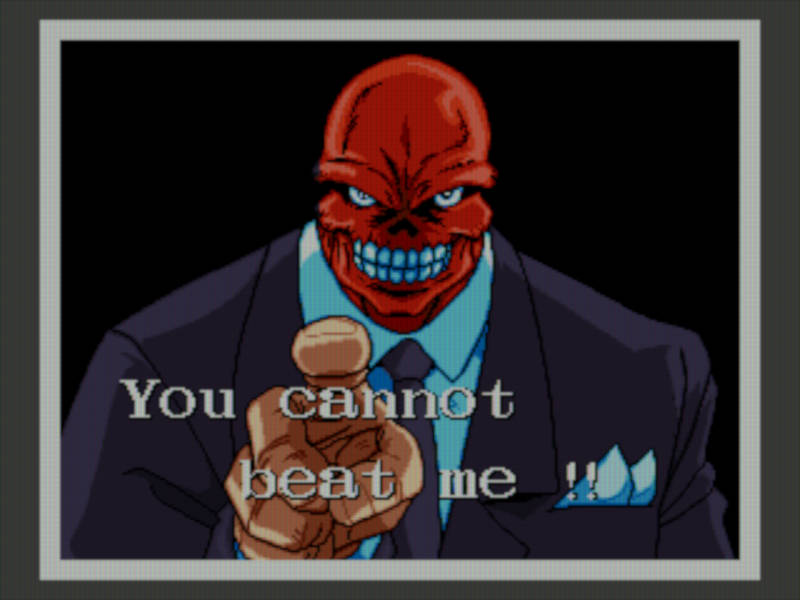
I need to make special note that as I write this, it’s the Fourth of July – Independence Day in the United States. So playing Captain America and the Avengers felt like an apropos way to commemorate the occasion. For better or worse though, this game was almost certainly intended to be played as a co-op experience, and yet again it’s one I tackled in solo fashion. So if you’re wondering why all the screenshots feature Captain America going it alone, that’s because … the Fourth of July, baby! Fireworks! Gunz! Monster Trucks! Budweiser! I’m only kidding of course; the reason this is a solo playthrough, is a simple lack of co-op players. Much like Konami’s X-men cab (which would be released the following year in 1992), some versions of Captain America and the Avengers could accommodate up to four players in the arcade, each playing as one of the four available Avengers characters. As far as that roster goes we have a couple of shoe-ins in the form of Captain America and Iron-Man. Next up and slightly off the beaten path, we have Hawkeye in his classic purple ‘Robin Hood but make it Glam’ outfit. And lastly, we have Vision whose inclusion here feels slightly puzzling to me. I mean, obviously he’s an Avenger, but why not include the Hulk or Thor, both of whom were founding members of the team? As far as the Hulk goes, my guess is that his powers didn’t lend themselves as well to the playstyle here (all playable characters in this game have a projectile attack), and perhaps the necessary sprite work would have presented challenges in terms of size. But Thor!? He would have been perfect for this game, chucking Mjolnir around to and fro like the glorious thunder god he is. Alas, it was not to be. But in defense of Cap and the Avengers, how many games really feature Vision as a principle playable character? This is almost certainly one of the few.
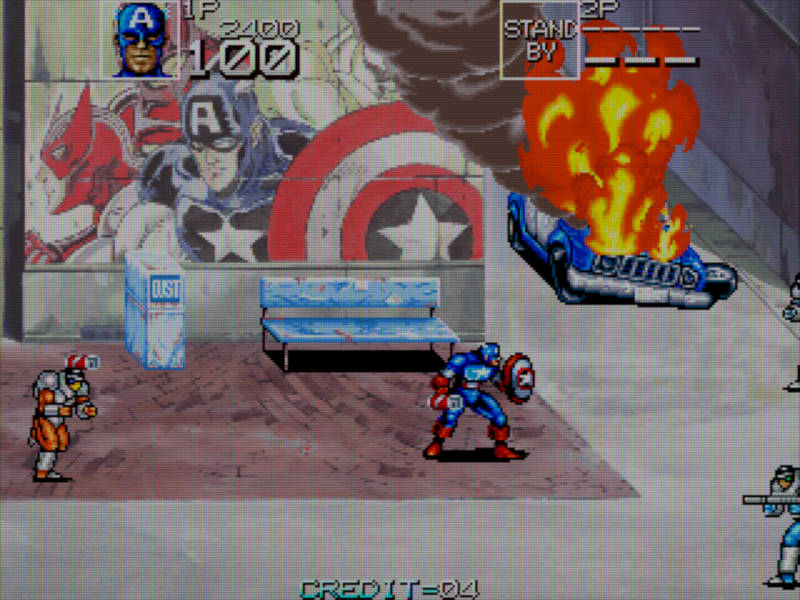
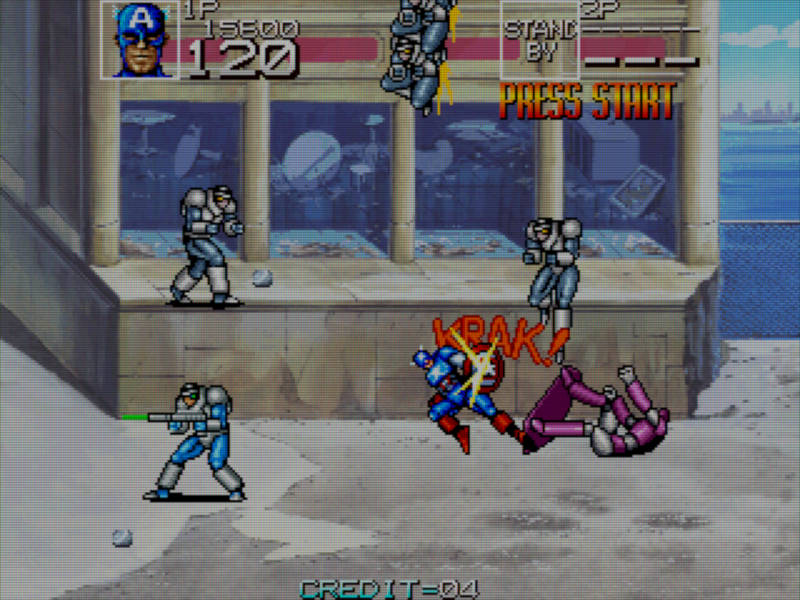
Oftentimes with arcade titles, we find that when story elements are present at all, they’re given extremely low priority in favor of gameplay and the consumption of quarters. For what it’s worth, Captain America and the Avengers bucks this trend, if only slightly. I’d hardly call this game ‘plot heavy’ in any sense, but it does indeed feature a rudimentary storyline conveyed via interspersed cutscenes. Essentially Red Skull has assembled a team of super villains through promises of wealth and the use of a mind control device. If I was a super-villain with a mind control device, I probably would have just gone that route full stop and saved my money for more important super-villain stuff, but whatever. So obviously it’s up to the Avengers to put an end to Red Skull’s schemes. To that end, they will do battle with Klaw, the Living Laser, Whirlwind, the Grim Reaper, the Mandarin, Ultron, the Controller (the villain, not the one in your hands), Crossbones, and the Juggernaut, bitch. While the Avengers have their hands full with fighting these well-paid, mind controlled super-villains, Red Skull is able to construct a super-weapon on the moon capable of destroying earth, should the planet not submit to his rule. So yeah, it’s your pretty basic ‘superheroes save the world’ story. Where it shines though is in how the story is told. Prior to starting the game and between each level, the story elements are presented via cinematic cutscenes featuring dynamic comic book panels. I really love it when superhero games make explicit reference to their comic book origins, and this is a clever way to tackle it here. It’s certainly a level of storytelling not typically seen in arcade games from this era. That said, some rather notorious localization gaffes rob the written dialog of much of its punch. We’re talking some real meme-worthy levels of mistranslation here. The most well-known of these occurs early in the game when Living Laser and Klaw warn off the Avengers with a stern, “Don’t disturb us!”. Undeterred in the slightest, our stalwart heroes naturally reply, “Why should it goes well?” Later in the game the heroes advise Whirlwind that he cannot escape, to which he replies, “YOU will be the one escaping!!” Finally, after defeating Red Skull at the end of the game, the Avengers are shown saying their immortal catchphrase, “Avengers Unite!” (despite the digitized voice correctly saying “Avengers Assemble!”). But let’s be real here; poor localization tends to give these games more personality rather than less, and if nothing else, mistakes like these are always good for a laugh.
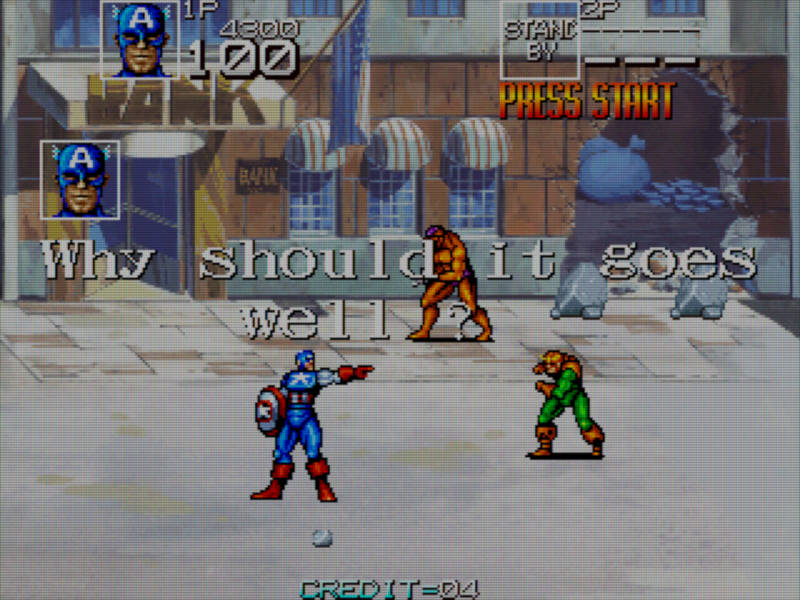
If you’ve not yet surmised it from the screenshots, what we’re looking at here is (predominantly) a classic belt-scrolling beat’em up. The concept of combining licensed properties with this style of gameplay was absolutely booming in arcades of the early 90’s. Within a span of five years, arcades around the world were blessed with: Teenage Mutant Ninja Turtles (1989), The Simpsons (1991), Captain America and the Avengers (1991), X-Men (1992), Cadillacs and Dinosaurs (1993), The Punisher (1993), and so on – each and every one of them an incredibly solid belt-scrolling beat’em up. So while the Avengers may have been one of the earlier examples in this milieu, you can see that they were really up against some stiff competition in the quest to gobble your quarters. How do Earth’s Mightiest fare against such a strong field of contenders? Well, taking a page from Tony Stark’s blueprints, they innovated on existing approaches by swapping out playstyles here and there. Interspersed throughout Captain America and the Avengers, your heroes take to the skies (and later into space) for some side scrolling shoot’em up action. These levels keep you on your toes thanks to the ever-shifting playstyle. Among other things this also helps set the Avengers apart from all the other great games mentioned above. As far as the beat’em up gameplay goes, it’s very solid. Your melee move set is fairly simple and should feel familiar to genre veterans. As mentioned briefly above though, each character also has a projectile attack, which is another slight twist on the standard beat’em up formula. These projectile attacks are a blast to use (literally and figuratively), as they feature unlimited usage. So you can fire off Cap’s shield as often you like and as rapidly as you can smash those buttons (or Iron-Man’s repulsor blasts, Hawkeye’s arrows, and Vision’s solar beams depending on your chosen character). It can actually feel slightly OP, but I mean … these are The Avengers; being slightly OP is pretty much baked right into their team identity. In point of fact, I think this is something a lot of superhero games tend to struggle with – imparting the power fantasy of being a superhero while at the same time presenting a reasonably challenging gameplay experience. It’s a balance that Captain America and the Avengers pulls off pretty well.
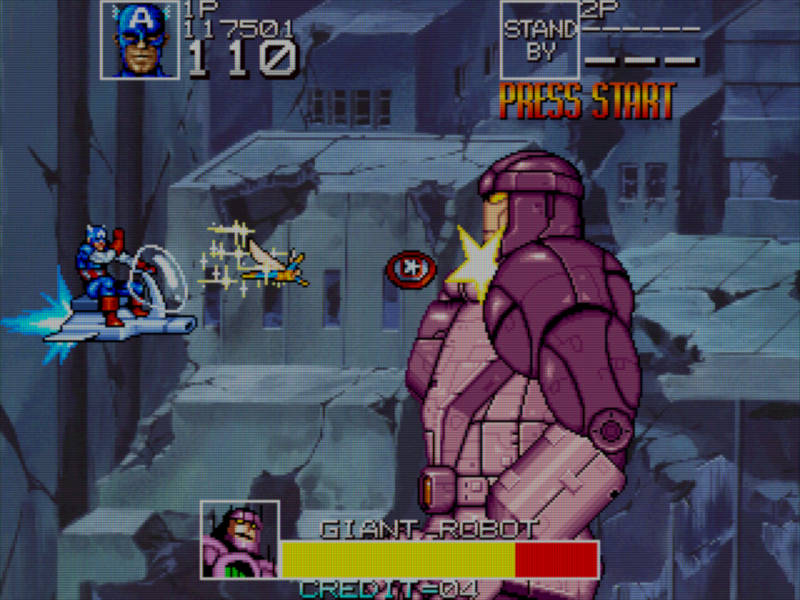
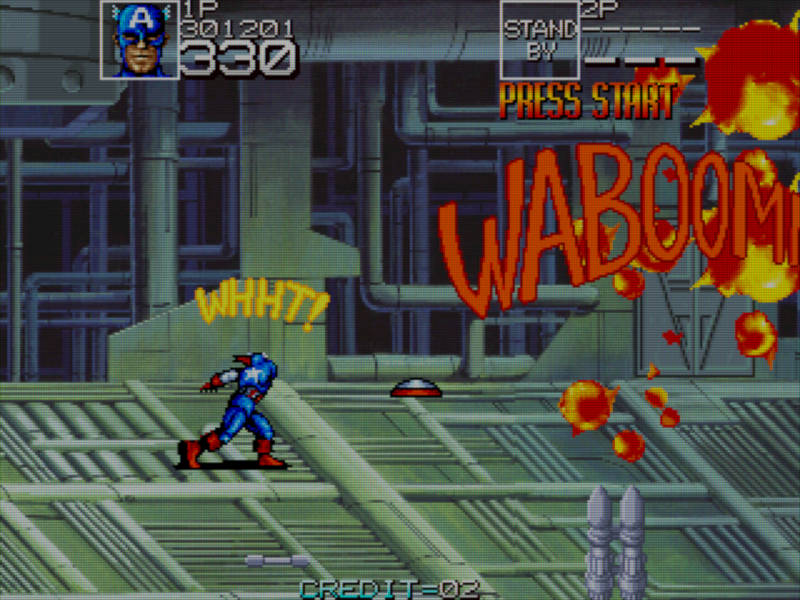
Likewise there’s a lot to admire about the game’s graphical presentation. Among other things it really nails the look and feel of silver age Marvel comics. Bright and bold colors rule the day, and elements of retro-futuristic design are liberally applied throughout. I mentioned the comic book panel cutscenes above, and they too further the impression of a playable comic come to life. Interestingly, the sprites in Captain America and the Avengers are neither as large nor as detailed as those in many other popular beat’em ups of the era. They’re smaller here than in any of the similar games I listed in the preceding paragraph. That’s not necessarily a bad thing though. The smaller sprites leave you with more screen real estate to maneuver around in, which helps facilitate crowd control in a big way. Sound design is also quite solid. The music is both catchy and energizing, as befits an arcade game of this type. But the real standout in terms of audio is the exemplary digitized voicework. Lines of spoken dialog are boisterous and clear, rather than static filled blasts of nonsense which inundated other games of this era. So in terms of presentation, the Avengers chalk up a solid win.
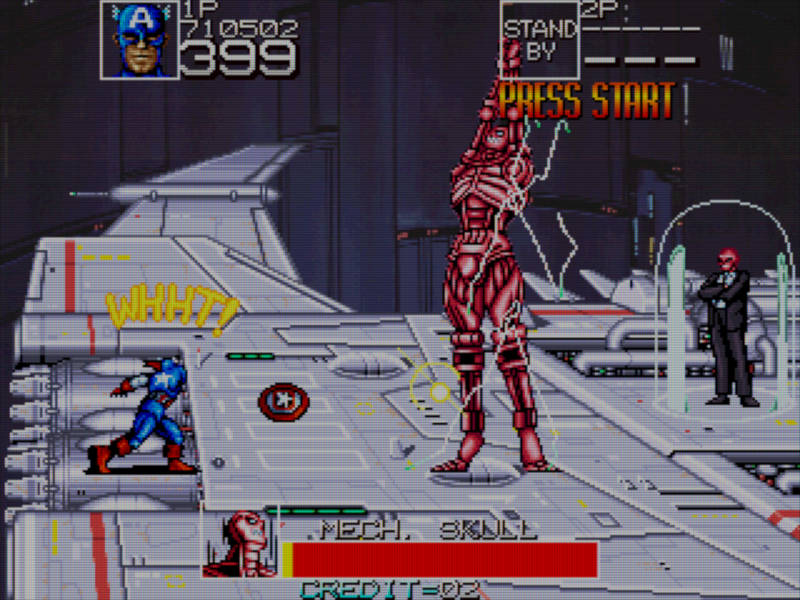
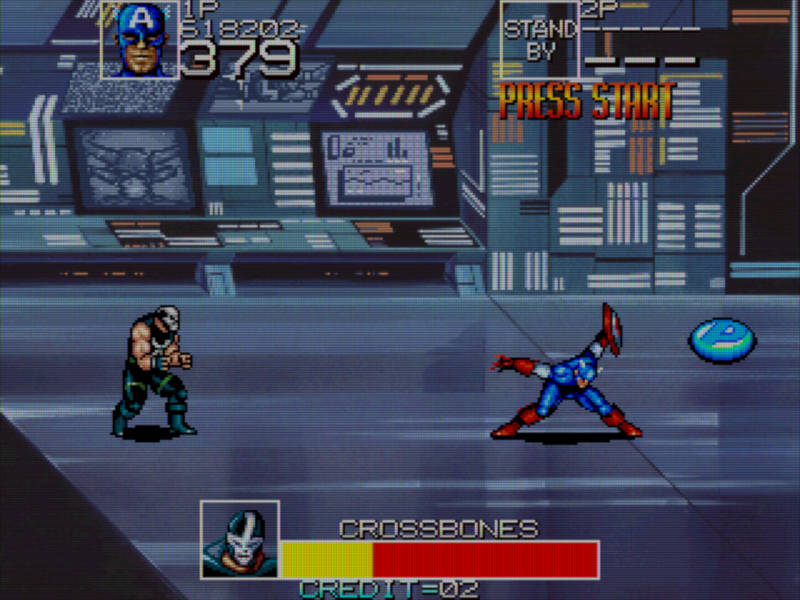
Aside from some janky localization, there truly is a lot to love about Captain America and the Avengers. It’s an above average beat’em up from an era that produced more than its share. It doesn’t quite propel itself fully towards legendary excellence, but it certainly doesn’t make any egregious missteps in gameplay. If you love this era of Marvel comics, or you’re curious to see what Marvel-based games were like prior to the MCU, Captain America and the Avengers should rank highly on your list. If only they had swapped out Vision for Thor, I likely would have awarded a whole extra point (by Odin’s beard, Vision fanboys, I only jest).
Final Verdict: 8 Avengers out of 10 Assemblies.
Leave a Reply